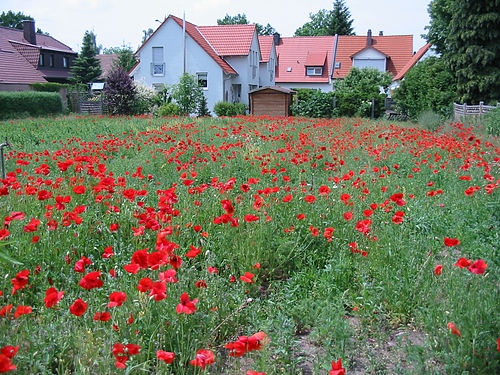Papaver rhoeas
| Habit | herbaceous
| |
|---|---|---|
| Lifespan: | ⌛ | annual |
| Bloom: | ❀ | late spring, early fall |
| Exposure: | ☼ | sun |
|---|---|---|
| Features: | ✓ | flowers |
| Flower features: | ❀ | red |
|
Papaver > |
rhoeas > |
The plant is a variable annual, forming a long-lived soil seed bank that can germinate when the soil is disturbed. In the northern hemisphere it generally flowers in late spring, but if the weather is warm enough other flowers frequently appear at the beginning of autumn. The flower is large and showy, with four petals that are vivid red, most commonly with a black spot at their base. Like many other species of Papaver, it exudes a white latex when the tissues are broken.
It is known to have been associated with agriculture in the Old World since early times. It has most of the characteristics of a successful weed of agriculture. These include an annual lifecycle that fits into that of most cereals, a tolerance of simple weed control methods, the ability to flower and seed itself before the crop is harvested.
Read about Papaver rhoeas in the Standard Cyclopedia of Horticulture
|
|---|
|
Papaver Rhoeas, Linn. Corn Poppy. Fig. 2750. Hispid annual, or rarely glabrescent. erect and branching, 1 to about 3 ft.: lvs. coarselv toothed (rarely nearly entire) to more or less pinnatifid, lanceolate in outline: bud oblong- ovoid, roundish at apex: petals orbicular or nearly so, entire or sometimes crenate or incised, cinnabar-red, deep purple to scarlet, white and variously marginate, sometimes dark-spotted, the fls. 2 in. or more across; stigmatic disk usually 10-radiate, but varying from 5-18. Eu. and Asia; run wild in N. Amer. Abundant in fields in Eu. Gn. 30, p. 297.—An immensely variable species,from 25-30 botanical varieties and subvarieties being recognized; and the cultural variations are numberless. In cult, every shade known to the opium poppy has been reproduced in the corn poppy, but the fls. are always smaller. In the wild it varies greatly, the foliage once or twice pinnately parted, the bristles many or few, appressed or spreading, the fls. spotted or not. Up to 1886 the French poppies were considered the best strain. Since then the strain or race known as Shirley poppies has surpassed all others. This strain was developed by the Rev. W. Wilks, secretary of the Royal Horticultural Society. (See p. 2456.) Var. ranunculi- florum, Hort., is a strain with double fls. in various colors, self and variegated, with the petals entire, rounded and somewhat reflexed. Var. japonicum, Hort., is a strain intro. about 1893 from Japanese gardens, and said to have smaller and fuller fls. than ordinary and of more varied shades. They are called Japanese or Japanese pompons. Rhaeas was the name used by the ancient Greeks and Romans for the corn poppy. Var. umbrosum, Mott. (P. umbrosum, Hort.), has petals of a darker red than the typical P. Rhoeas, and blackish spots. It was intro. by Vilmorin about 1891, and was considered a marked gain in productiveness. The habit is dwarf, compact, much branched. Soon after a double form was distributed. Mottet considers it a form of P. Rhoeas, but some botanists consider it a form of P. commutatum, a species apparently not otherwise in garden cult. P. umbrosum was found growing wild in Attica. Var. Hookeri, W. Miller (P. Hookeri, Baker). A puzzling plant found in gardens of India, and of unknown parentage. It is nearest to P. Rhoeas, and "differs in its great size, for it forms a bushy herb 4 ft. high and upward, and in the great number of the stigmatic rays, which are 12-20, i. e., nearly double those of P. Rhoeas; the fls., caps, and seeds also are much larger and the stigma broader in proportion." The fls. attain 3 1/2 in. diam., and vary from pale rose to bright crimson, with a white or black spot at the base. B.M. 6729. Gn. 29, p. 139. G.C. II. 25:9.— Said to revert occasionally to P. Rhoeas. The flower-garden forms of P. Rhoeas give remarkable color effects. Probably no plant so quickly and cheaply satisfies ones love of colour. The season of bloom, which is mostly July in the N., is rather short, but it may be considerably extended by succes-sional sowings and by not allowing the plants to seed. Begin to sow as early as the land can be put in condition. Cover lightly, or the germination may be unsatisfactory. Thin to 6-12 in. apart. Self-sown seeds give earlier-blooming plants. CH
|
Cultivation
- Do you have cultivation info on this plant? Edit this section!
Propagation
- Do you have propagation info on this plant? Edit this section!
Pests and diseases
- Do you have pest and disease info on this plant? Edit this section!
Species
Gallery
If you have a photo of this plant, please upload it! Plus, there may be other photos available for you to add.
References
- Standard Cyclopedia of Horticulture, by L. H. Bailey, MacMillan Co., 1963
External links
- w:Papaver rhoeas. Some of the material on this page may be from Wikipedia, under the Creative Commons license.
- Papaver rhoeas QR Code (Size 50, 100, 200, 500)






